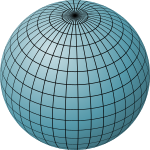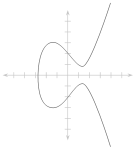Genus g surface
In mathematics, a genus g surface (also known as a g-torus or g-holed torus) is a surface formed by the connected sum of g distinct tori: the interior of a disk is removed from each of g distinct tori and the boundaries of the g many disks are identified (glued together), forming a g-torus. The genus of such a surface is g.
A genus g surface is a
Definition of genus
The genus of a connected orientable surface is an
The genus (sometimes called the demigenus or Euler genus) of a connected non-orientable closed surface is a positive integer representing the number of
Genus 0
An orientable surface of genus zero is the sphere S2. Another surface of genus zero is the disc.
- Representations of genus 0 surfaces
-
A sphere
-
A closed disc (with boundary)
Genus 1
A genus one orientable surface is the ordinary torus. A non-orientable surface of genus one is the projective plane.[2]
- Representations of genus 1 surfaces
-
A torus of genus 1
-
An elliptic curve
Genus 2
The term double torus is occasionally used to denote a genus 2 surface.[4] A non-orientable surface of genus two is the Klein bottle.
The Bolza surface is the most symmetric Riemann surface of genus 2, in the sense that it has the largest possible conformal automorphism group.[5]
- Representations of genus 2 surfaces
-
A torus of genus 2
Genus 3
The term triple torus is also occasionally used to denote a genus 3 surface.[6]
The Klein quartic is a compact Riemann surface of genus 3 with the highest possible order automorphism group for compact Riemann surfaces of genus 3. It has 168 orientation-preserving automorphisms, and 336 automorphisms altogether.
- Several genus 3 surfaces
-
A sphere with threehandles
-
Thetori
-
Triple torus
-
Tetradecagon with opposite edges identified[7]
See also
- Three-torus
- g-torus knot
References
- ^ Munkres, James R. Topology. Vol. 2. Upper Saddle River: Prentice Hall, 2000.
- ISBN 0-387-97926-3.
- ISBN 0-387-96203-4.
- ^ Weisstein, Eric W. "Double Torus". MathWorld.
- JSTOR 2369402
- ^ Weisstein, Eric W. "Triple Torus". MathWorld.
- ^ a b Jürgen Jost, (1997) "Compact Riemann Surfaces: An Introduction to Contemporary Mathematics", Springer
Sources
- James R. Munkres, Topology, Second Edition, Prentice-Hall, 2000, ISBN 0-13-181629-2.
- William S. Massey, Algebraic Topology: An Introduction, Harbrace, 1967.










![Dodecagon with opposite edges identified[7]](http://upload.wikimedia.org/wikipedia/commons/thumb/7/73/Dodecagon_with_opposite_faces_identified.svg/150px-Dodecagon_with_opposite_faces_identified.svg.png)
![Tetradecagon with opposite edges identified[7]](http://upload.wikimedia.org/wikipedia/commons/thumb/e/e3/14-gon_with_opposite_faces_identified.svg/150px-14-gon_with_opposite_faces_identified.svg.png)